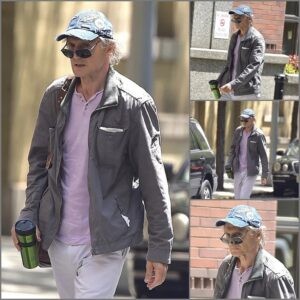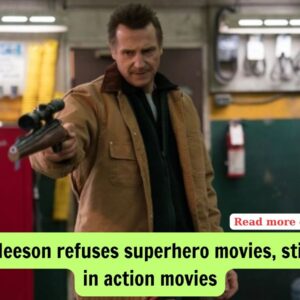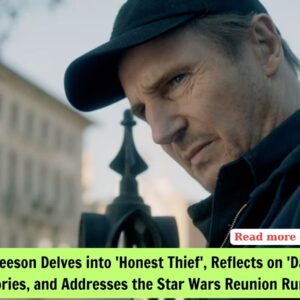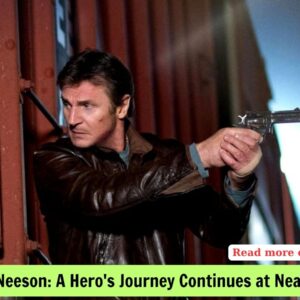The veteran actor talks about reteaming with his ‘The Marksman’ helmer Robert Lorenz on ‘In the Land of Saints and Sinners’ and why he loves a fast-paced shoot: “You shouldn’t be taking endless takes.”

Liam Neeson was 56 when his career took an unexpected detour into the action hero genre thanks to 2008’s Taken, a Pierre Morel-directed surprise blockbuster that raked in more than $226 million worldwide and kick-started a franchise.
He’s kept up a respectable pace ever since, churning out high-octane thrillers one after the next — and he’s not ready to hang up his holster.
“Audiences are innately intelligent and they’ll know when you’re past your prime in regards to throwing punches and firing guns, but I’m not there yet,” explained Neeson over Zoom last week while discussing his newest film, In the Land of Saints and Sinners.
The Samuel Goldwyn Films release casts Neeson, who will be 72 in June, as Finbar Murphy, a man leading a relatively quiet life in the remote coastal town of Glencolmcille, Ireland, in the 1970s. While he’s eager to leave a dark past behind, a menacing crew of terrorists arrives in the village, led by a ruthless woman, played by Banshees of Inisherin star Kerry Condon, forcing him to choose between revealing his secret identity or protecting his neighbors.
The film, which premiered last fall at the Venice Film Festival, offered Neeson more than another chance to hold a gun. It delivered another chance to work with his The Marksman helmer Robert Lorenz and a huge bonus in being surrounded by a cast of high-profile Irish actors, many of whom he counts as close friends, including Ciarán Hinds and Colm Meaney.
Neeson talks to The Hollywood Reporter about working with his longtime pals, how he came to sign on for the Naked Gun sequel and the upcoming film that also stars his mother-in-law, Vanessa Redgrave, whom he expects to “steal the whole movie.”
Let’s talk about Finbar Murphy, who is not a typical hitman. He reads Fyodor Dostoevsky and has a conscience. What appealed to you most about playing him?
It’s a shame, actually, that doesn’t he have a more Irish name, right? It was a chance to work with Rob Lorenz, again, who is terrific director. This is our second time out, and we’re actively looking for a third.
It was also a chance to work with the brother that I never had, Ciarán Hinds; my oldest friend, Colm Meaney; Jack Gleeson; and the lovely Kerry Condon, she’s terrific. And I just thought it was a good, modern-day Western set up in the northwest of Ireland. It was a good shoot. Tom Stern, our director of photography, he was with me in Australia, and we’ve done four films together. He’s just quick and keeps a great pace. This film ticked all the boxes.
With all the Irish talent together, how does that impact the set?
Well, with these particular ones, Ciarán, Colm, Jack, Kerry and myself, we all leave our egos at the door. When you’re called to the set, you go. You don’t wait half an hour or 40 minutes like some actors and actresses do. We’re there to shoot the film, tell the story. Colm, I’ve known for 40 years, and Ciarán, 50 years. Egos are left at the door and we get on with it.

Ciarán Hinds (left) and Liam Neeson. COURTESY OF SAMUEL GOLDWYN FILMS
You mentioned the pace of filming, and I was thinking about the pace that you keep when it comes to turning out back-to-back movies. When you’re working, what are the rules you abide by to keep the trains moving so that you’re able to keep up that momentum?
You take the time where it’s needed, but the films that I do are the kind of fairly fast-paced thrillers. You shouldn’t be taking endless takes, you know what I mean? That can dampen down the energy on set, both in front of the camera and behind it, too. I’ve done shoots like that, and it’s like pulling teeth. I’ve been really lucky. Rob comes from the Clint Eastwood school of filming, having done, I don’t know, maybe 15 films together. Clint doesn’t hang around. I personally love that pace.

Jack Gleeson (left) and Liam Neeson. COURTESY OF SAMUEL GOLDWYN FILMS
You’ve obviously found a great partner in Rob, like you said, filming The Marksman, this movie and you said you’re looking for a third together. What is it about him?
He gets it. Obviously, the building block is the script and if it’s a good story and we like it and we’re committed to it, then what’s the most expedient way to shoot this and to enjoy ourselves. I don’t mean that we’re cracking jokes all the time, but there can be a lovely, healthy, experienced ambience on set.
Tom, Rob, myself, Ciarán, Colm and Kerry, we have a lot of experience between us and it’s great to use that experience, without patting yourself on the back or blowing smoke up your ass. You have a sort of unspoken communication, at least I do with Rob and certain directors. You don’t have to intellectualize each scene and discuss the importance of this moment, you know what I mean? You just get it.

Neeson in a scene from Robert Lorenz’s In the Land of Saints and Sinners. COURTESY OF SAMUEL GOLDWYN FILMS
Speaking of the script and story, I imagine you connected with it on a deeper level. You grew up in Ireland at a time when there was a lot of violence and car bombings. What do you remember?
I remember a lot. First and foremost, I wasn’t involved in anything, nor was Ciarán, who was brought up in Belfast. My hometown was 30 miles outside Belfast, but I was a university then, 1971 and ’72. It was bad.
You could hear bombs going off, drive-by shootings and stuff. It was a very, very nasty, horrible time for everybody. So, it’s interesting to do a film like this, which is entertainment and yet it’s based on a reality that happened. We didn’t bloat on it when we were shooting, but we all just got it.
It’s interesting, though, when I tell my American pals about growing up in the north of Ireland where we were surrounded by violence, military violence, para-military violence and the constant news about The Troubles, I guess that leads to a certain amount of post-traumatic stress disorder.
I don’t feel it, but there had to be something. Maybe that gets released in some way with a film like Saints and Sinners. I don’t know. But when I am talking about it or when someone asks me a question about it, I think to myself, “Gosh, that did happen. Bloody hell.”
Switching gears, I wanted to ask you about your upcoming work schedule. I see that you’re doing the Naked Gun sequel. After a spate of intense action movies, I would imagine it must be appealing to do a comedy. What else appealed to you about taking that on?
News
“Liam Neeson’s Surprise: Shocking Appearance Raises Eyebrows on the Street”
Liam Neeson, 63 years old, famous actor with a series of roles in action movies: “Taken”, “Non-stop”… appeared thin and haggard on the streets of New York…
“Liam Neeson on Embracing Action Roles at 70: ‘I’m Getting Away with It’”
Liam Neeson is looking back at becoming an unlikely action star with 2008’s Taken Liam Neeson’s age isn’t getting in the way of his status as an action…
Liam Neeson refuses superhero movies, still acts in action movies
Although Liam Neeson has no plans to star in any more superhero movies, he said he will continue to participate in action movies. (Photo: The Playlist) Liam…
“Liam Neeson Delves into ‘Honest Thief’, Reflects on ‘Darkman’ Memories, and Addresses the Star Wars Reunion Rumors”
He also reveals which of his films he’d love to have revisited with a sequel. From writer/director Mark Williams (co-creator of the Netflix series Ozark), the crime drama Honest Thief tells the…
Liam Neeson’s action thriller suffers due to predictable twists, rushed ending
Liam Neeson’s Retribution is strictly a one-time watch for action star’s fans. However, a few of them might get disheartened as well. Liam Neeson’s films of late…
“Is ‘Made In Italy’ Worth the Watch? Analyzing Liam Neeson’s Movie Reviews and Rotten Tomatoes Scores”
The Liam Neeson movie Made In Italy is currently proving surprisingly popular on Netflix, but is this largely forgotten 2020 dramedy worth watching? SUMMARY Made In Italy…
End of content
No more pages to load






